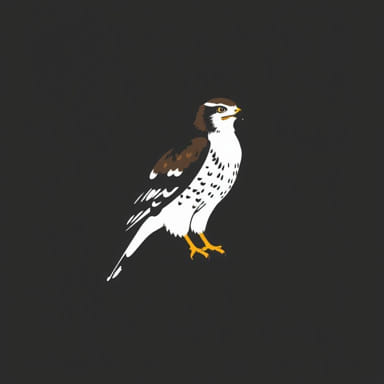Among the many birds of prey found throughout North America, the Sharp-shinned Hawk stands out for its agility, speed, and elusive nature. In Georgia, these raptors can be spotted particularly during migration periods or in suitable forest habitats. Their small size and sharp hunting instincts make them both fascinating to watch and difficult to track. Bird enthusiasts and researchers in Georgia often consider spotting a Sharp-shinned Hawk a special experience due to the bird’s quick movements and stealthy behavior.
Overview of the Sharp-shinned Hawk
Physical Characteristics
The Sharp-shinned Hawk (Accipiter striatus) is the smallest hawk in North America. Adult birds feature blue-gray upperparts, a reddish-orange barring on the chest, and long, square-tipped tails with dark bands. Their eyes are often fiery red or orange. Juveniles are brown above and streaked with brown on the breast. One of the key distinguishing traits is their thin legs, which appear surprisingly delicate for a bird of prey.
- Length: Approximately 9 to 13 inches
- Wingspan: 17 to 22 inches
- Weight: 3 to 8 ounces
Behavior and Diet
Sharp-shinned Hawks are known for their stealthy hunting tactics. They typically hunt smaller birds such as sparrows, finches, and other songbirds. They rely on surprise and speed, flying low through dense woods and ambushing prey. Occasionally, they may also eat insects or small mammals. Their ability to navigate through trees with precision makes them master predators in forested environments.
Habitat and Range in Georgia
Preferred Habitat
Sharp-shinned Hawks prefer densely wooded areas for nesting and hunting. In Georgia, they can be found in mixed hardwood and pine forests, especially in the northern and central regions. During migration, they may also pass through more open landscapes, such as agricultural fields and suburban areas, where bird feeders attract prey.
Seasonal Movement
In Georgia, the Sharp-shinned Hawk is most commonly seen during fall and spring migrations. Some individuals do winter in Georgia, particularly in the southern part of the state, where the climate is milder and prey remains abundant. Breeding, however, typically occurs farther north or in higher elevations.
- Spring Migration: March to May
- Fall Migration: September to November
- Wintering Range: Southern Georgia and coastal regions
Identifying the Sharp-shinned Hawk in the Field
Tips for Birdwatchers
Because they are often confused with the slightly larger Cooper’s Hawk, identifying a Sharp-shinned Hawk requires careful observation. Look for smaller body size, a squared-off tail when perched, and a more abrupt head profile. When flying, Sharp-shinned Hawks have quick wingbeats followed by short glides, a pattern that distinguishes them from larger hawks.
Common Sightings in Georgia
Sharp-shinned Hawks are often spotted near wooded backyard bird feeders, especially in the fall. They are drawn to areas where small birds congregate. They may also be seen soaring above ridgelines during migration or darting through forests at high speed. Look for them in areas such as:
- Chattahoochee National Forest
- Okefenokee National Wildlife Refuge
- Panola Mountain State Park
- Backyards and suburbs with dense tree cover
Conservation Status and Challenges
Population Trends
Sharp-shinned Hawks are not currently considered threatened or endangered. However, their populations have fluctuated in the past due to habitat loss and the effects of pesticide use, particularly DDT. Since the banning of DDT, populations have generally recovered, though monitoring continues due to their sensitivity to environmental changes.
Human Impact and Threats
Urbanization and forest fragmentation can affect nesting and hunting success. Additionally, collisions with windows during pursuit of prey at backyard feeders pose a significant risk. Conservation groups recommend positioning bird feeders and windows in ways that reduce strike risk to both prey and predator birds.
Role in the Ecosystem
Ecological Importance
As mid-level predators, Sharp-shinned Hawks play an essential role in maintaining balance in bird populations. They help control populations of smaller birds, which in turn influences insect control and seed dispersal patterns. Their presence is a sign of a healthy, biodiverse ecosystem.
Educational and Recreational Value
For birdwatchers in Georgia, observing a Sharp-shinned Hawk offers a thrilling and educational opportunity. Their speed, agility, and mysterious behavior provide insight into the intricate food web of local forests. Many birding groups host hawk watches during peak migration times, offering enthusiasts a chance to learn more about these birds and contribute to citizen science projects.
How to Support Sharp-shinned Hawks
Conservation at Home
Residents of Georgia can support Sharp-shinned Hawks and other raptors by maintaining natural vegetation, planting native trees and shrubs, and reducing the use of pesticides. Creating bird-friendly habitats also attracts the smaller birds that hawks rely on for food.
Ethical Bird Feeding Practices
If you use bird feeders, be mindful that they may attract raptors. To reduce window collisions:
- Place feeders within 3 feet of a window to reduce impact velocity
- Apply decals or screens to windows to prevent reflection confusion
- Provide cover such as nearby bushes to help smaller birds escape if pursued
The Sharp-shinned Hawk in Georgia remains an elusive but captivating bird of prey. With its small size, fast flight, and bold hunting strategies, it exemplifies the wonders of nature’s adaptability. Whether you’re an experienced birder or a casual nature lover, spotting one of these hawks in Georgia’s diverse habitats is always a memorable experience. Continued conservation efforts and public education will help ensure that Sharp-shinned Hawks continue to soar across Georgia’s skies for generations to come.
